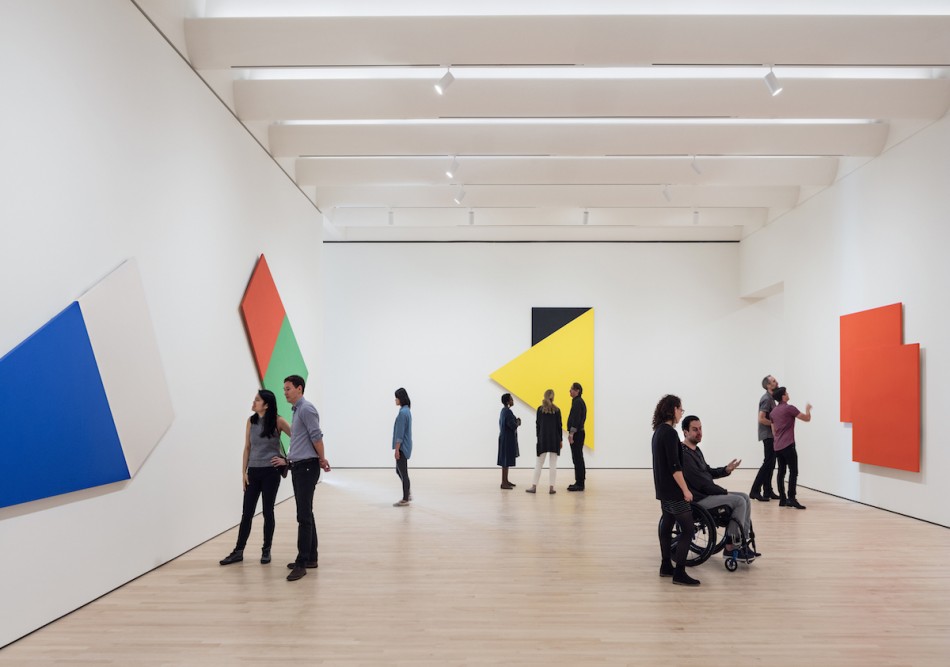
Approaching American Abstraction The Fisher Collection exhibition; photo © Henrik Kam, courtesy SFMOMA
SFMOMA Cruise Ship Makes Port With Trophies Aboard
Rich donors are to shiny new art museums what electricity is to Teslas. In San Francisco, companies like the Gap (founded 1969) and Apple Computer (1976) seized the new American economy and mindset well before the first dot-com boom. Doris and Donald Fisher, who founded the Gap and began collecting art to hang in their offices in the late 1970s, have top donor billing at SFMOMA’s reopening, with 260 collection works on view (in a 100-year loan arrangement); their son Robert is president of the SFMOMA board. Following in second place are Charles and Helen Schwab, who endow director Neal Benezra’s job. (Charles Schwab’s San Francisco launch dates to 1971.)
Today in San Francisco, protests against gentrification by working artists cross media. I watched network news reports about violations by the chuffing tech buses that pick up tech workers in Soma to take them to the Silicon Valley campuses. Narratives of the data visualization and analysis collective Anti-Eviction Mapping Project are housed on a website that storytells histories of no-fault evictions in San Francisco 1997-2015. (The project was part of a group show last May, The Dissidents, The Displaced and the Outliers at Random Parts in Oakland.) Meanwhile in New York, a recent show at Printed Matter and a book, A History of Colab (and Related Activities), trace the history of the artist-run group that occupied 123 Delancey Street in the New Year’s Day 1980 “Real Estate Show.” Being locked out from the one-day squat resulted in a New York City agency giving the Colab artists control of 156 Rivington, which became ABC No Rio.
If this seems irrelevant to the opening of a new art museum in San Francisco, it is not.
The super-size clout the donors evidently had in the programming comes at a huge cost of diversity. Not only gender and racial diversity, but diversity revealing northern California’s own modern art history. Where was work by Jay De Feo? Survival Research Laboratory? The Capp Street Project? Guerrilla poster artist extraordinaire, Robbie Conal? Representation of the decimations of the AIDS crisis that so profoundly affected San Francisco? A bow to the intense, outrageous performative past in this city? Or the Chicano grassroots arts that have animated Galeria de la Raza since its formation in the Mission in 1970?
Why are so many works by single artists — male artists who enjoy art-superstar reputations — hung as if animating visual encyclopedia entries, occupying one gallery upon the next upon the next? And whose idea was it to do it this way?
For the influential donors of the new SFMOMA, political art appears never to have been invented.
Designed by architecture firm Snøhetta under lead architect Craig Dykers, the facts of place have been widely reported: A cost of $305 million took the museum to seven floors, added 100,000 square feet of gallery space (galleries now total 170,000 square feet), and spells probable LEED Gold certification in the near future. Techie gee-gaws include mobile phone-in-pocket tours with voiceovers by comedians from the HBO show Silicon Valley, as well as by San Francisco Giants baseball players and a roller-derby player.
These whistles may signal the call at hand to attract new audiences for this museum, which was closed almost three years for its redo. In 2016, San Francisco’s population stood slightly above 800,000 (whites: 48%; Asians: a third), with a median age for both men and women of 38 years old— putting their birth year just a couple of years before the start of the AIDS crisis.
The enormous galleries, which Jason Farago in the Guardian called “joyless,” appear to have been built for a hanging of trophy multiples by Baselitz, Calder, Close, Kelly, Kentridge, Kiefer, Lichtenstein, Richter, Serra, Twombly and Warhol. Adjunct to that list are two women: Agnes Martin and Joan Mitchell. I saw a Helen Frankenthaler and a couple of Sherrie Levines. (I admittedly did not see everything.) As to African-American contemporary artists, Glenn Ligon’s work was edged into a corner of the Campaign for Art floor, where Mark Bradford had slightly more breathing room. A press release of future solo exhibitions coming in the next year reveals Runa Islam as the sole woman among seven men.
Is a past commission for Sarah Sze or a future one for Julie Mehretu really adequate by way of representation? Even, in the Pritzker Center for Photography, the inclusion of a large Jim Goldberg body of 1970s work, Rich and Poor, doesn’t capture the embodied politics of San Francisco art.
The modern collection is indeed majestically impressive. Most spectacular to me were the Ellsworth Kelly rooms. In 1999, the Fishers, the Schwabs and Mimi and Peter Haas got together to purchase 19 paintings directly from Kelly; he also gave three of his early paintings to SFMOMA at that time. You can see the impact of this purchase-gift in the spectacular, Ellsworth Kelly Multi-Panel Paintings gallery that exhibits a grouping including Yellow Relief with Black (1993), Red on Red (2001), Black Triangle with White (1976), Red Curves (1996), and two 1968 paintings. Kelly’s death last December makes this tribute all the more moving.
Some might suggest that my quarrel is actually a quarrel with the pecuniary direction (listening, Stefan Simchowitz?) the art world has traveled. While finishing this post, I noticed that Art Market Monitor last year re-reported what it claimed had been a flawed record about the 1973 altercation between Bob Rauschenberg and art collector Robert Scull at a Sotheby’s Parke Bernet sale. The original tale goes that an aghast Rauschenberg socked Bob Scull in the stomach, angry about the prices at which Scull sold work that he had bought for a song. This latter-day version holds that the punch was actually a shove, after which the two men fell into an instant truce and “nervous laughter” as it dawned on Rauschenberg that new art’s inflationary trends would benefit him, too.
So if one can get past the issue of the donors wanting to demonstrate by example to a next-generation of contemporary collector, the larger issue is how fundamentally, all this emphasis on the trophies compresses the story of art. There’s not much new to say about Kiefer or Richter. Hey, rich collectors on the west coast buy the same names that rich New York collectors do. And they don’t much care if evictions and tech buses aren’t popular with young or old artists today.
The new architecture from the outside resembles a cruise ship lit from within, glittering trophies in its hold.
Snøhetta did away with most traces of Mario Botta’s earlier museum, consigning the former to just about the status of a ballroom floor, such that one wonders why the original museum was kept at all.
On the new entry floor, a Sol Lewitt mural of blue ground with white wavy squiggles is truncated in a way that turns it from art into a design element. And this too is notably important: San Francisco is a city with new star power in design. The 2016 National Design Awards honor San Francisco firms Ammunition in product design, and Studio O and A in interiors. Why do I need to learn about them in New York? Where are they? Where is new work by San Francisco interaction design firms? And who, in designing this museum, construed it wise to create curvy gray floor guards for underneath the Alexander Calder sculptures?
Fundamentally, though, here’s the beef. Frontloading the art experience as a collection of trophies strips out this fact. Art’s fundamental DNA is un-belonging, a character extending to rejection of systems.
You truly would not know that here.
San Francisco wanted, even needed, a world-class museum. The architecture is a tight, tall maze — with beautiful maple staircases. The gallery spaces re-propose the idea of scale as grandeur. But the grandeur of the Palace of the Louvre can’t be achieved anymore, even if what is posited on Howard Street is that new tech oligarchs sign up to be San Francisco’s future princes bestowing contemporary art pedigree on the city on the Bay.

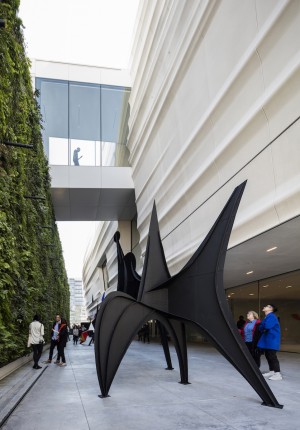
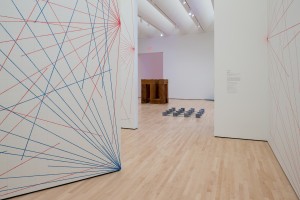
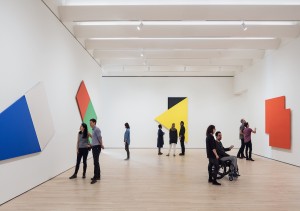
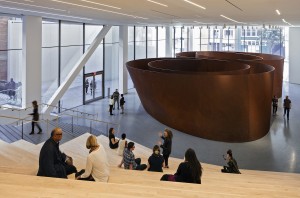
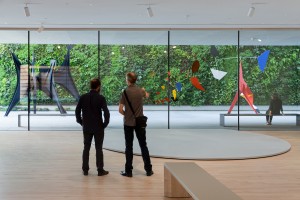
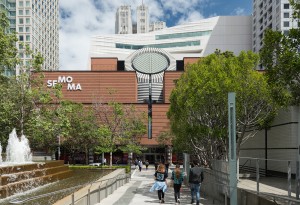
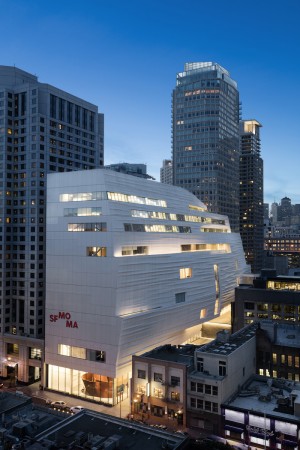
It remains a sad abuse of the 100’s of gifted artists, who over decades, left historical legacies in the Bay Area, but ultimately had to leave due to lack of financial support or neglect. I have not seen the redo or the exhibition yet however this piece affirms we all have come to distain: the same 15 guys in every newly built museum. “Product as Art.”
Hi Ellen,
Nice to see the Airstream back cruisin’!
Bruce